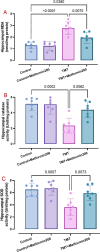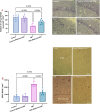Metformin Mitigates Trimethyltin-Induced Cognition Impairment and Hippocampal Neurodegeneration
- PMID: 39441380
- PMCID: PMC11499442
- DOI: 10.1007/s10571-024-01502-4
Metformin Mitigates Trimethyltin-Induced Cognition Impairment and Hippocampal Neurodegeneration
Abstract
The neurotoxicant trimethyltin (TMT) triggers cognitive impairment and hippocampal neurodegeneration. TMT is a useful research tool for the study of Alzheimer's disease (AD) pathogenesis and treatment. Although the antidiabetic agent metformin has shown promising neuroprotective effects, however, its precise modes of action in neurodegenerative disorders need to be further elucidated. In this study, we investigated whether metformin can mitigate TMT cognition impairment and hippocampal neurodegeneration. To induce an AD-like phenotype, TMT was injected i.p. (8 mg/kg) and metformin was administered daily p.o. for 3 weeks at 200 mg/kg. Our results showed that metformin administration to the TMT group mitigated learning and memory impairment in Barnes maze, novel object recognition (NOR) task, and Y maze, attenuated hippocampal oxidative, inflammatory, and cell death/pyroptotic factors, and also reversed neurodegeneration-related proteins such as presenilin 1 and p-Tau. Hippocampal level of AMP-activated protein kinase (AMPK) as a key regulator of energy homeostasis was also improved following metformin treatment. Additionally, metformin reduced hippocampal acetylcholinesterase (AChE) activity, glial fibrillary acidic protein (GFAP)-positive reactivity, and prevented the loss of CA1 pyramidal neurons. This study showed that metformin mitigated TMT-induced neurodegeneration and this may pave the way to develop new therapeutics to combat against cognitive deficits under neurotoxic conditions.
Keywords: AMP-activated protein kinase; Alzheimer’s; Metformin; Neurodegeneration; Neuroprotection; Trimethyltin.
© 2024. The Author(s).
Conflict of interest statement
There is no conflict of interest to express.
Figures






Similar articles
-
HMG-CoA reductase inhibitor simvastatin ameliorates trimethyltin neurotoxicity and cognitive impairment through reversal of Alzheimer's-associated markers.Metab Brain Dis. 2024 Dec 20;40(1):74. doi: 10.1007/s11011-024-01515-4. Metab Brain Dis. 2024. PMID: 39704877
-
Myricetin alleviates learning and memory deficits in trimethyltin Alzheimer's phenotype via attenuating hippocampal endoplasmic reticulum stress and regulating inflammation and oxidative stress.Brain Res Bull. 2025 Jul;227:111382. doi: 10.1016/j.brainresbull.2025.111382. Epub 2025 May 16. Brain Res Bull. 2025. PMID: 40383238
-
Sinomenine Attenuates Trimethyltin-Induced Cognitive Decline via Targeting Hippocampal Oxidative Stress and Neuroinflammation.J Mol Neurosci. 2022 Aug;72(8):1609-1621. doi: 10.1007/s12031-022-02021-x. Epub 2022 May 11. J Mol Neurosci. 2022. PMID: 35543800
-
Neuroprotective strategies in hippocampal neurodegeneration induced by the neurotoxicant trimethyltin.Neurochem Res. 2013 Feb;38(2):240-53. doi: 10.1007/s11064-012-0932-9. Epub 2012 Nov 25. Neurochem Res. 2013. PMID: 23179590 Review.
-
Trimethyltin-induced hippocampal neurodegeneration: A mechanism-based review.Brain Res Bull. 2016 Jul;125:187-99. doi: 10.1016/j.brainresbull.2016.07.010. Epub 2016 Jul 20. Brain Res Bull. 2016. PMID: 27450702 Review.
Cited by
-
Overview of Metformin and Neurodegeneration: A Comprehensive Review.Pharmaceuticals (Basel). 2025 Mar 28;18(4):486. doi: 10.3390/ph18040486. Pharmaceuticals (Basel). 2025. PMID: 40283923 Free PMC article. Review.
-
Promising neuroprotective potential of naringenin against trimethyltin-induced cognitive deficits and hippocampal neurodegeneration in rats.Front Neurosci. 2025 May 23;19:1567236. doi: 10.3389/fnins.2025.1567236. eCollection 2025. Front Neurosci. 2025. PMID: 40486726 Free PMC article.
-
Combined exercise and Hawthorn protect against learning impairments and hippocampal damage from trimethyltin neurotoxicity in rat.Sci Rep. 2025 Jul 8;15(1):24563. doi: 10.1038/s41598-025-08414-3. Sci Rep. 2025. PMID: 40628832 Free PMC article.
-
Aerobic exercise and metformin attenuate the cognitive impairment in an experimental model of type 2 diabetes mellitus: focus on neuroinflammation and adult hippocampal neurogenesis.Metab Brain Dis. 2025 Jan 7;40(1):92. doi: 10.1007/s11011-024-01489-3. Metab Brain Dis. 2025. PMID: 39775196
References
-
- Abosharaf HA, Elsonbaty Y, Tousson E, Mohamed TM (2024) Alzheimer’s disease-related brain insulin resistance and the prospective therapeutic impact of metformin. J Neuroendocrinol 36(1):e13356 - PubMed
-
- Anderson T, Sharma S, Kelberman MA, Ware C, Guo N, Qin Z, Weinshenker D, Parent MB (2024) Obesity during preclinical Alzheimer’s disease development exacerbates brain metabolic decline. J Neurochem 168(5):801–821 - PubMed
MeSH terms
Substances
Grants and funding
LinkOut - more resources
Full Text Sources
Miscellaneous

